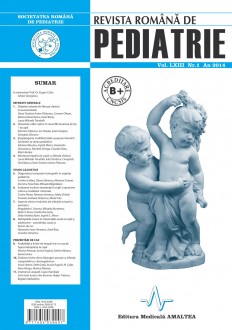SELECT ISSUE

Indexed

| |

|
|
|
| |
|
|
|

|
|
|
|
|
|
|
HIGHLIGHTS
National Awards “Science and Research”
NEW! RJP has announced the annually National Award for "Science and Research" for the best scientific articles published throughout the year in the official journal.
Read the Recommendations for the Conduct, Reporting, Editing, and Publication of Scholarly work in Medical Journals.
The published medical research literature is a global public good. Medical journal editors have a social responsibility to promote global health by publishing, whenever possible, research that furthers health worldwide.
COMPUTED TOMOGRAPHY IMAGING IN THE PEDIATRIC EMERGENCY DEPARTMENT
Cristina Coldea, Diana Stanescu, Mariana Coman, Dumitru Ferechide and Mihaela Balgradean
ABSTRACT
Introduction. The Computerised Tomography (CT) plays a crucial role in the emergency diagnosis.
Objective. Our purpose was to identify CT-scan’s utility in Pediatric Emergency Department.
Materials and methods. We used a cross-sectional approach, for the year 2010. From a total of 92959 visits in the Emergency Room (ER) of the “Clinical Emergency Hospital for Children “M.S. Curie”, Bucharest, 9258 patients were considered emergencies (group A) and 90 patients were major emergencies (group B). We performed 102 CT scans. Results were given as percents.
Results. The global percent of ER visits associated with a CT scan was 1% within the group A and it scored 1‰ from all ER visits. All patients from group B underwent a CT scan. Main indications were: major head injuries - 50%, intracranial hypertension – 35%, polytrauma – 12.7%, suspicions of malformations – 5.9%. The global detection rate for any kind of lesion was 51%. For brain trauma the rate scored 49%, identifying the following lesions: diffuse cerebral edema (19%), intracranial hemorrhage (15.6%), skull fractures (15.6%) and other facial or visceral lesions (29%). For intracranial hypertension the method’s sensitivity was 43%, for multiple trauma 84.6% and for malformations’ suspicions 100%. The lesions’ detection rate, for different clinical conditions (or the method’s sensitivity) is similar with other medical studies.
Conclusion. In all pediatric patients, indication of a CT scan was made after a careful selection of cases. The method proved to be useful for managing all kind of trauma and intracranial hypertension situations.
Keywords: CT, emergency, trauma, intracranial hypertension
